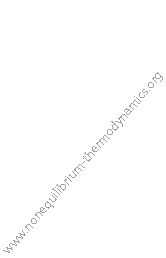

|
| 5th International Workshop on Nonequilibrium Thermodynamics IWNET 2009 |
|
Home Scope Location Invited speakers Program Book of abstracts Author index Organizing committee Scientific committee Venue Registration Accommodation Contact  |
Poster P1.4 Monday 16:00 Hydrodynamic correlation functions of nematic liquid crystals under shear and flexoelectric deformation [1] Facultad de Ciencias, Universidad Nacional Autonoma de Mexico, Circuito Exterior de Ciudad Universitaria, 04510, Mexico D.F., Mexico, [2] Instituto de Fisica, Universidad Nacional Autonoma de Mexico, Apartado Postal 20-364, 01000 Mexico, D.F., Mexico Abstract: We use a fluctuating hydrodynamic description in order to calculate the velocity and orientation (director) correlation functions of hydrodynamic fluctuations for a nematic liquid crystals in a non-equilibrium steady state produced by both, a planar shear flow and an external uniform electric field, which induces an elastic deformation through the so called flexoelectric effect. We fully analyze the effects of these external gradients to estimate the changes on the light scattering spectrum produced by both gradients with respect to its equilibrium shape. We find that these non-equilibrium effects give rise to an asymmetry of the spectrum, which consists on an increment of its maximum and a displacement in the frequency shift space. These changes are proportional to the magnitude of the external gradients and depend also on the relative orientation of the gradients with respect to the wave vector. We find that shear flow can produce significant changes on dynamic correlations. Specifically, it can induce a maximum degree of change of the dynamic structure factor of 5%, for normalized velocity gradients of the order 0.1 << 1. On the other hand, the flexoelectric effect produces only small changes on the structure factor, which are about two orders of magnitude smaller with respect to those due to the presence of the shear flow. Our analysis suggests that the effects produced on dynamic correlations by the flexoelectric effect would be hard to observe in experiments, while those due to the shear flow could be detected. |
| ||
 |
||||
|
©
|